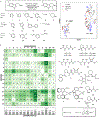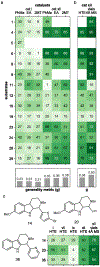Screening for generality in asymmetric catalysis
- PMID: 36049504
- PMCID: PMC9645431
- DOI: 10.1038/s41586-022-05263-2
Screening for generality in asymmetric catalysis
Abstract
Research in the field of asymmetric catalysis over the past half century has resulted in landmark advances, enabling the efficient synthesis of chiral building blocks, pharmaceuticals and natural products1-3. A small number of asymmetric catalytic reactions have been identified that display high selectivity across a broad scope of substrates; not coincidentally, these are the reactions that have the greatest impact on how enantioenriched compounds are synthesized4-8. We postulate that substrate generality in asymmetric catalysis is rare not simply because it is intrinsically difficult to achieve, but also because of the way chiral catalysts are identified and optimized9. Typical discovery campaigns rely on a single model substrate, and thus select for high performance in a narrow region of chemical space. Here we put forth a practical approach for using multiple model substrates to select simultaneously for both enantioselectivity and generality in asymmetric catalytic reactions from the outset10,11. Multisubstrate screening is achieved by conducting high-throughput chiral analyses by supercritical fluid chromatography-mass spectrometry with pooled samples. When applied to Pictet-Spengler reactions, the multisubstrate screening approach revealed a promising and unexpected lead for the general enantioselective catalysis of this important transformation, which even displayed high enantioselectivity for substrate combinations outside of the screening set.
© 2022. The Author(s), under exclusive licence to Springer Nature Limited.
Conflict of interest statement
Figures




Comment in
-
A leap forward in the quest for general catalysts.Nature. 2022 Oct;610(7933):632-633. doi: 10.1038/d41586-022-03173-x. Nature. 2022. PMID: 36216948 No abstract available.
References
-
- Knowles WS, Sabacky MJ & Büthe H Catalytic asymmetric hydrogenation employing a soluble, optically active, rhodium complex. Chem. Commun. (London), 1445–1446 (1968).
-
- Horner L, Siegel H & Büthe H Asymmetric catalytic hydrogenation with an optically active phosphine–rhodium complex in homogeneous solution. Angew. Chem. Int. Ed, 7, 942 (1968).
-
- Jacobsen EN, Pfaltz A & Yamamoto H, Eds. Comprehensive Asymmetric Catalysis, vols. 1–3 (Springer, 1999).
-
- Katsuki T & Sharpless KB The First Practical Method for Asymmetric Epoxidation. J. Am. Chem. Soc 102, 5974–5976 (1980).
-
- Jacobsen EN, Marko I, Mungall WS, Schroeder G & Sharpless KB Asymmetric dihydroxylation via ligand-accelerated catalysis. J. Am. Chem. Soc 110, 1968–1970 (1988).
Publication types
MeSH terms
Substances
Grants and funding
LinkOut - more resources
Full Text Sources
Other Literature Sources
Medical
Miscellaneous

